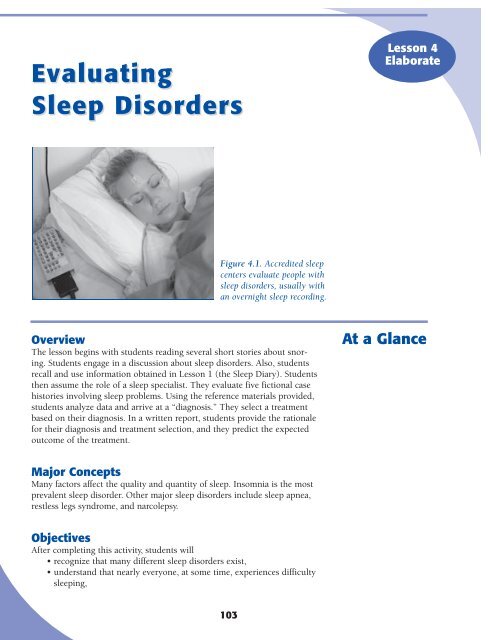Biological - NIH Office of Science Education - National Institutes of ...
Biological - NIH Office of Science Education - National Institutes of ...
Biological - NIH Office of Science Education - National Institutes of ...
Create successful ePaper yourself
Turn your PDF publications into a flip-book with our unique Google optimized e-Paper software.
Evaluating<br />
Sleep Disorders<br />
Lesson 4<br />
Elaborate<br />
Figure 4.1. Accredited sleep<br />
centers evaluate people with<br />
sleep disorders, usually with<br />
an overnight sleep recording.<br />
Overview<br />
The lesson begins with students reading several short stories about snoring.<br />
Students engage in a discussion about sleep disorders. Also, students<br />
recall and use information obtained in Lesson 1 (the Sleep Diary). Students<br />
then assume the role <strong>of</strong> a sleep specialist. They evaluate five fictional case<br />
histories involving sleep problems. Using the reference materials provided,<br />
students analyze data and arrive at a “diagnosis.” They select a treatment<br />
based on their diagnosis. In a written report, students provide the rationale<br />
for their diagnosis and treatment selection, and they predict the expected<br />
outcome <strong>of</strong> the treatment.<br />
At a Glance<br />
Major Concepts<br />
Many factors affect the quality and quantity <strong>of</strong> sleep. Insomnia is the most<br />
prevalent sleep disorder. Other major sleep disorders include sleep apnea,<br />
restless legs syndrome, and narcolepsy.<br />
Objectives<br />
After completing this activity, students will<br />
• recognize that many different sleep disorders exist,<br />
• understand that nearly everyone, at some time, experiences difficulty<br />
sleeping,<br />
103

















